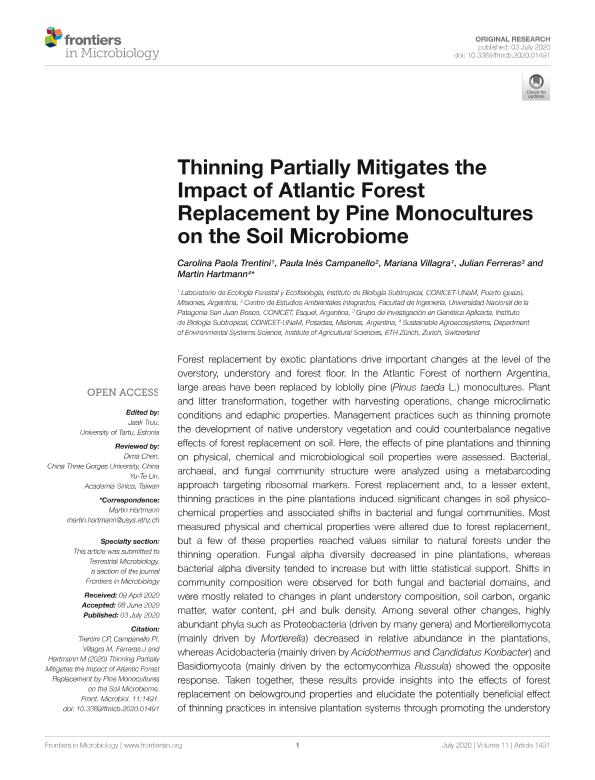Mostrar el registro sencillo del ítem
dc.contributor.author
Trentini, Carolina Paola

dc.contributor.author
Campanello, Paula Inés

dc.contributor.author
Villagra, Mariana

dc.contributor.author
Ferreras, Julian Alberto

dc.contributor.author
Hartmann, Martin
dc.date.available
2021-05-20T14:56:12Z
dc.date.issued
2020-07
dc.identifier.citation
Trentini, Carolina Paola; Campanello, Paula Inés; Villagra, Mariana; Ferreras, Julian Alberto; Hartmann, Martin; Thinning partially mitigates the Impact of atlantic forest replacement by pine monocultures on the soil microbiome; Frontiers Media S.A.; Frontiers in Microbiology; 11; 7-2020; 1-18
dc.identifier.issn
1664-302X
dc.identifier.uri
http://hdl.handle.net/11336/132345
dc.description.abstract
Forest replacement by exotic plantations drive important changes at the level of the overstory, understory and forest floor. In the Atlantic Forest of northern Argentina, large areas have been replaced by loblolly pine (Pinus taeda L.) monocultures. Plant and litter transformation, together with harvesting operations, change microclimatic conditions and edaphic properties. Management practices such as thinning promote the development of native understory vegetation and could counterbalance negative effects of forest replacement on soil. Here, the effects of pine plantations and thinning on physical, chemical and microbiological soil properties were assessed. Bacterial, archaeal, and fungal community structure were analyzed using a metabarcoding approach targeting ribosomal markers. Forest replacement and, to a lesser extent, thinning practices in the pine plantations induced significant changes in soil physico-chemical properties and associated shifts in bacterial and fungal communities. Most measured physical and chemical properties were altered due to forest replacement, but a few of these properties reached values similar to natural forests under the thinning operation. Fungal alpha diversity decreased in pine plantations, whereas bacterial alpha diversity tended to increase but with little statistical support. Shifts in community composition were observed for both fungal and bacterial domains, and were mostly related to changes in plant understory composition, soil carbon, organic matter, water content, pH and bulk density. Among several other changes, highly abundant phyla such as Proteobacteria (driven by many genera) and Mortierellomycota (mainly driven by Mortierella) decreased in relative abundance in the plantations, whereas Acidobacteria (mainly driven by Acidothermus and Candidatus Koribacter) and Basidiomycota (mainly driven by the ectomycorrhiza Russula) showed the opposite response. Taken together, these results provide insights into the effects of forest replacement on belowground properties and elucidate the potentially beneficial effect of thinning practices in intensive plantation systems through promoting the understory development. Although thinning did not entirely counterbalance the effects of forest replacement on physical, chemical and biological soil properties, the strategy helped mitigating the effects and might promote resilience of these properties by the end of the rotation cycle, if subsequent management practices compatible with the development of a native understory vegetation are applied.
dc.format
application/pdf
dc.language.iso
eng
dc.publisher
Frontiers Media S.A.

dc.rights
info:eu-repo/semantics/openAccess
dc.rights.uri
https://creativecommons.org/licenses/by-nc-sa/2.5/ar/
dc.subject
ATLANTIC FOREST
dc.subject
BIODIVERSITY
dc.subject
PINUS TAEDA
dc.subject
PLANT UNDERSTORY
dc.subject
SOIL MICROBIOME
dc.subject
THINNING PRACTICE
dc.subject.classification
Ecología

dc.subject.classification
Ciencias Biológicas

dc.subject.classification
CIENCIAS NATURALES Y EXACTAS

dc.title
Thinning partially mitigates the Impact of atlantic forest replacement by pine monocultures on the soil microbiome
dc.type
info:eu-repo/semantics/article
dc.type
info:ar-repo/semantics/artículo
dc.type
info:eu-repo/semantics/publishedVersion
dc.date.updated
2021-04-28T20:04:45Z
dc.journal.volume
11
dc.journal.pagination
1-18
dc.journal.pais
Alemania

dc.journal.ciudad
Berlin
dc.description.fil
Fil: Trentini, Carolina Paola. Consejo Nacional de Investigaciones Científicas y Técnicas. Centro Científico Tecnológico Conicet - Nordeste. Instituto de Biología Subtropical. Instituto de Biología Subtropical - Nodo Puerto Iguazú | Universidad Nacional de Misiones. Instituto de Biología Subtropical. Instituto de Biología Subtropical - Nodo Puerto Iguazú; Argentina
dc.description.fil
Fil: Campanello, Paula Inés. Consejo Nacional de Investigaciones Científicas y Técnicas. Centro Científico Tecnológico Conicet - Nordeste. Instituto de Biología Subtropical. Instituto de Biología Subtropical - Nodo Puerto Iguazú | Universidad Nacional de Misiones. Instituto de Biología Subtropical. Instituto de Biología Subtropical - Nodo Puerto Iguazú; Argentina. Universidad Nacional de la Patagonia "San Juan Bosco"; Argentina
dc.description.fil
Fil: Villagra, Mariana. Consejo Nacional de Investigaciones Científicas y Técnicas. Centro Científico Tecnológico Conicet - Nordeste. Instituto de Biología Subtropical. Instituto de Biología Subtropical - Nodo Puerto Iguazú | Universidad Nacional de Misiones. Instituto de Biología Subtropical. Instituto de Biología Subtropical - Nodo Puerto Iguazú; Argentina
dc.description.fil
Fil: Ferreras, Julian Alberto. Universidad Nacional de Misiones. Facultad de Ciencias Exactas, Químicas y Naturales; Argentina. Consejo Nacional de Investigaciones Científicas y Técnicas. Centro Científico Tecnológico Conicet - Nordeste. Instituto de Biología Subtropical. Instituto de Biología Subtropical - Nodo Puerto Iguazú | Universidad Nacional de Misiones. Instituto de Biología Subtropical. Instituto de Biología Subtropical - Nodo Puerto Iguazú; Argentina
dc.description.fil
Fil: Hartmann, Martin. Institute of Agricultural Sciences; Suiza
dc.journal.title
Frontiers in Microbiology
dc.relation.alternativeid
info:eu-repo/semantics/altIdentifier/doi/http://dx.doi.org/10.3389/fmicb.2020.01491
dc.relation.alternativeid
info:eu-repo/semantics/altIdentifier/url/https://www.frontiersin.org/articles/10.3389/fmicb.2020.01491/full
Archivos asociados
